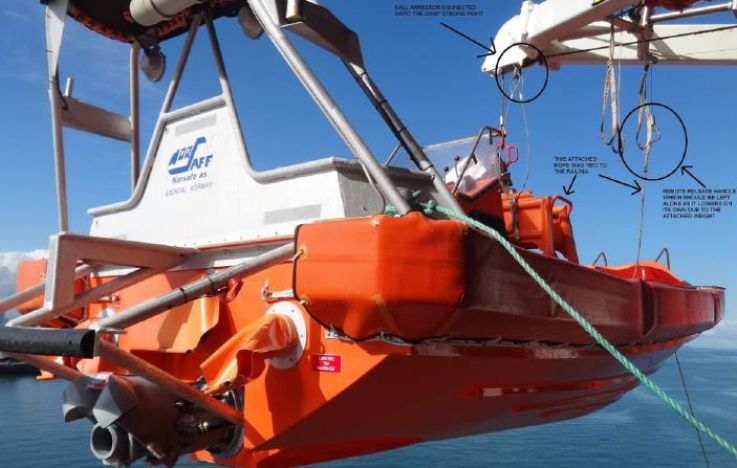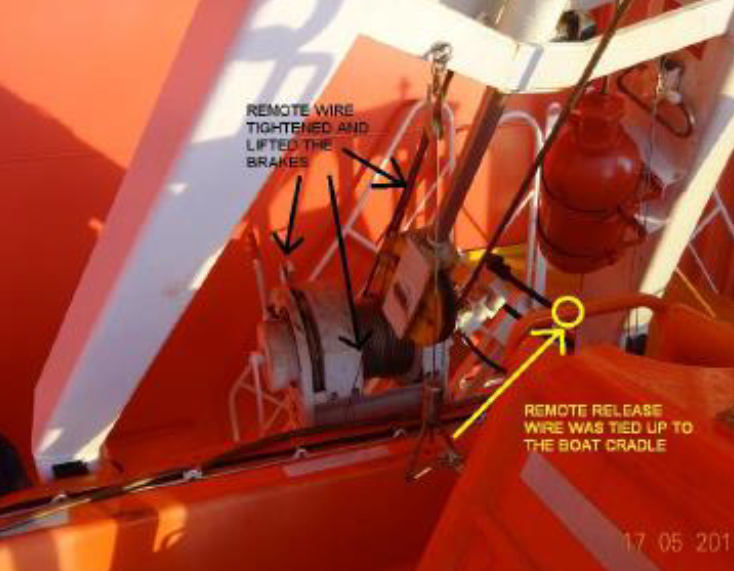Small boat deployment near miss incident
What happened?
A vessel was carrying out a monthly rescue boat drill when, as a result of procedures not being followed, there was a sudden and unplanned deployment of the boat into the sea. No-one was injured, and no equipment was damaged. Appropriate permission from Port control had been granted; a permit to work was in place, together with a risk assessment, and all hazards had been discussed before launch.
The lashings of the rescue boat were released and the boat was lowered to embarkation level. Painter lines were controlled by two crew members, and three crew members entered the rescue boat for launching. Two of these persons had safety harnesses connected to a fall arrestor at a strongpoint on the davit. The third had a safety harness connected to a ladder on the vessel through a rope which he held onto during lowering.
The remote-control wire was tied to the boat to prevent it from swinging during launching. The lowering of the boat was controlled by joystick from the control station. The remote-control wire became tight (since it was tied to the boat) about 5 meters above sea level and the electric motor tripped. This caused the rescue boat to descend under the influence of gravity until it was waterborne. As a result, the fall arrestors became activated and two crew members were left hanging 5 meters above the rescue boat. The third man followed the boat until it was waterborne.
Power was restored and the boat safely hoisted to deck level with all crew members.


What went wrong? What were the causes?
The immediate cause of the incident was carelessness – the remote-control wire was tied up to the boat. A causal factor was that the correct launching procedures not followed. The root causes were determined to be:
- Lack of training;
- Instructions not followed.
What lessons were learnt? What actions were taken?
- Crew to be trained in correct launching procedure as per manufacturer’s instructions;
- All boat crew should be using fall arrestors if available on board during launching and recovery of rescue boat drills and training;
- Review of maintenance instructions and certification of fall arrestors;
- Review and update risk assessment for small boat launch and drill.
Members may wish to review the following incidents:
Safety Event
Published: 5 October 2017
Download: IMCA SF 24/17
IMCA Safety Flashes
Submit a Report
IMCA Safety Flashes summarise key safety matters and incidents, allowing lessons to be more easily learnt for the benefit of all. The effectiveness of the IMCA Safety Flash system depends on Members sharing information and so avoiding repeat incidents. Please consider adding safetyreports@imca-int.com to your internal distribution list for safety alerts or manually submitting information on incidents you consider may be relevant. All information is anonymised or sanitised, as appropriate.
IMCA’s store terms and conditions (https://www.imca-int.com/legal-notices/terms/) apply to all downloads from IMCA’s website, including this document.
IMCA makes every effort to ensure the accuracy and reliability of the data contained in the documents it publishes, but IMCA shall not be liable for any guidance and/or recommendation and/or statement herein contained. The information contained in this document does not fulfil or replace any individual’s or Member's legal, regulatory or other duties or obligations in respect of their operations. Individuals and Members remain solely responsible for the safe, lawful and proper conduct of their operations.
